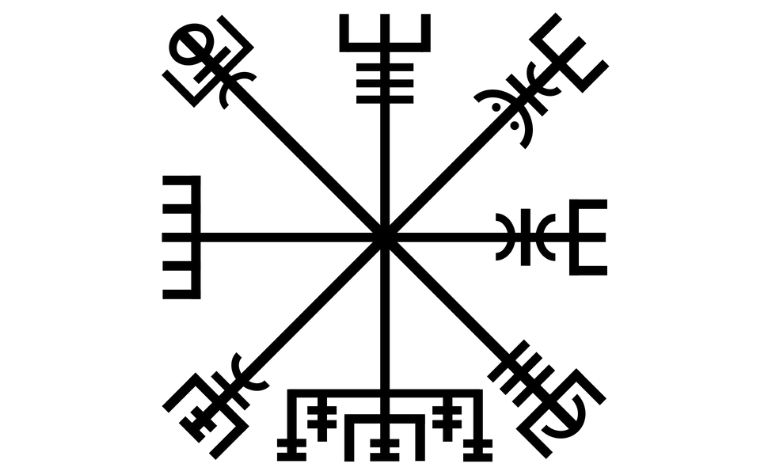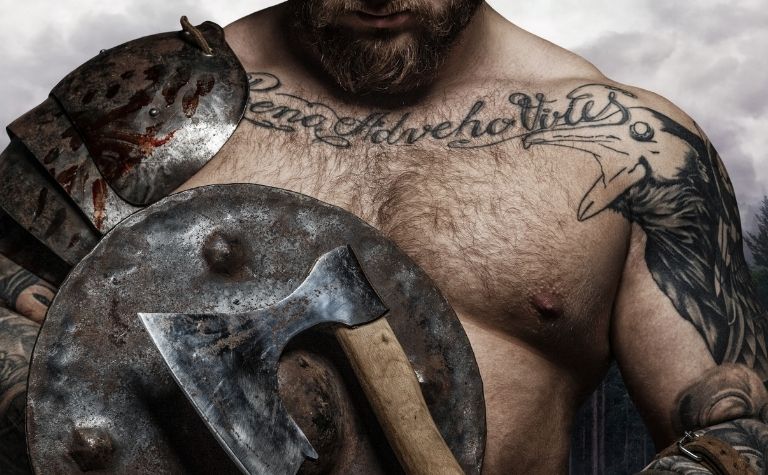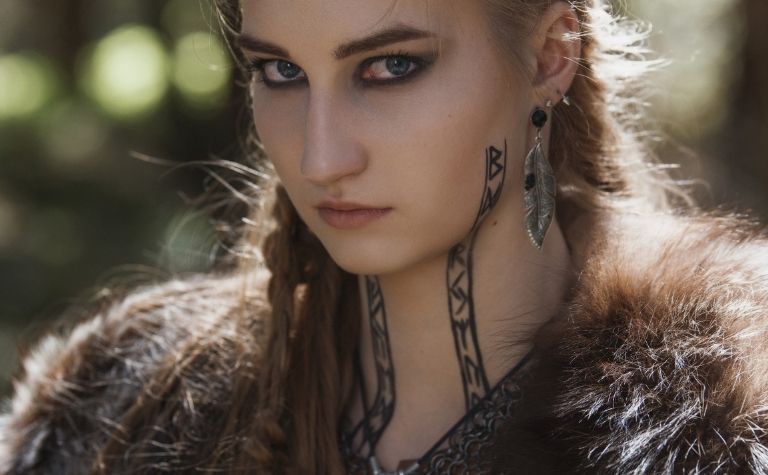From the 8th through the 11th centuries, the Vikings terrorized towns and nations throughout Europe.
These Norse warriors overwhelmed opposing forces with their fighting skills. Even the Vikings’ appearance struck fear in the hearts of their opponents and victims. But did they have tattoos?
Reliable historical accounts indicate that the Vikings had prominent markings on their skin, including the Vegvisir and Helm of Awe, but whether or not the etchings were equivalent to modern tattoos is inconclusive.
The Vikings were courageous warriors who fought without fear of death, but beautiful craftsmen and artists were among them.
They were masters of intimidation, which involved aspects of their appearance.
From the dragon heads carved into the bows of their longboats to the markings on their skin, the Vikings projected such an impression of power and brutality that battles were half-won at the mere sight of them.
Are you curious about what the Vikings looked like? See What Did the Vikings Look Like? to learn what scientists believe about their faces, hairstyles, clothing, skin color, and more.

The Vikings Likely Had Impressive Tattoos
It is difficult to say definitively that the Vikings had tattoos. The simple reasons for this are:
- There have been no archeological finds of Viking remains that demonstrate or indicate the presence of tattoos on their bodies (there are only skeletal remains).
- The Vikings did not maintain a comprehensive written record of their society and culture, as they had mostly oral traditions for passing down their people’s knowledge. The Icelandic sagas, which form the main body of historical accounts about the Vikings, were written after the fact (and by Christians).
Fortunately, other societies during the Viking Age maintained written records, and one in particular provides a detailed account.
An Arabic scholar named Ahmad Ibn Fadlan traveled to the Volga area (modern-day Russia) at the caliphate’s request in what is now Iraq.
During the Middle Ages, Volga was a bustling trade center, and the Vikings had strong trade relations with the Arab world.
During these travels, Ibn Fadlan encountered a people known locally as the Rus, and whom he called the Rusiyyah. (Also see 15 Facts About Viking Women)
As it turned out, these traders “tall as palm trees, fair and reddish” were none other than Vikings from Sweden, who sailed to Volga in their longboats to trade goods like Scandinavian furs, which were in high demand during those times.
When describing their physical appearance, Ibn Fadlan noted that the Rusiyyah had tattoos that began at their fingertips and continued up their arms to their necks.
The Arabic scholar described the ink as dark green in appearance, but it was likely dark blue as that was the color that would have been achieved using wood ash, which was the skin coloring agent of those times. [1]
A lot of people wonder what the Vikings looked like. For example, what did their hair look like, and how did they wear it? See Did Vikings Have Long Hair? to learn more.

Other Historical Accounts of Viking Tattoos
Another historical account of Viking tattoos also came from an Arabic source, as an emissary named al-Tartushi described seeing tattoos on Vikings’ arms and chests while visiting a busy trade hub in Hedeby, which is now a part of Germany.
The tattoos he saw depicted animals and trees, along with unfamiliar patterns. Al-tartushi also observed that the Vikings wore seemingly permanent eye makeup around their eyes that enhanced their good looks and gave them a youthful appearance. [2]

Here is What the Vikings Likely Tattooed on Themselves
Although the descriptions by the Arabic travelers of the Viking tattoos they observed vaguely mention unfamiliar patterns, trees, animals, and little else, it is not difficult to imagine what symbols would have been so significant to the Vikings that they tattooed them on their bodies.
These markings would have meant a lot to the Vikings and likely would have been unrecognizable to others.
Here are the likeliest candidates for how the Vikings tattooed themselves:
- Yggdrasil – The Norse tree of life had enormous branches that held the nine realms of the Viking cosmos, including Asgard, the realm of the gods, and Midgard, which was Earth. As such, this would have been a significant symbol to the Vikings and would undoubtedly fit al-Tartushi’s description of the tree-like tattoos he saw on the Vikings. (Also see the Yggdrasil Tree: The Sacred Ash Tree of Norse Mythology)
- Vegvisir – This compass-like symbol signified a divine power that would guide Vikings through stormy and hazardous conditions. The bearer of the Vegvisir would be shown the right path throughout the length of any journey, whether it took place on the high seas in a longboat or in a more spiritual sense, the life choices one would face from birth until death.
- Aegishjalmur – Known as the Helm of Awe, this symbol represented protection to those who bore it on themselves or their battle gear. Some thought the Aegishjalmur had magical properties, creating an impenetrable sphere around the protected party and casting misfortune and defeat upon others.
- Mjolnir – The magical hammer of Thor was a prevalent symbol among Viking warriors. Mjolnir was the lightning to Thor’s thunder. It not only represented tremendous power of such magnitude that it could slay fearsome giants and level mountains, but it also symbolized great fortitude, fearlessness, and determination.

- Gungnir – According to Norse mythology, the all-father Odin’s mighty spear never missed its mark and always struck with deadly effect. As a symbol closely associated with the god of war and wisdom, Gungnir would have represented bravery and victory on the battlefield. According to Norse sagas, before any battle unfolded, the Vikings hurled a spear over the heads of their enemies.
- Longboat – Perhaps the most fitting symbol of the Viking Age was the vessel that carried these warriors to their targets throughout Northern Europe and goods that the Norse merchants traded with other societies. The longboats of chieftains featured dragon heads carved into their bows (and the sterns on some ships) that struck fear in the hearts of those who saw them approaching. [3]
Are modern depictions of Viking clothing accurate? See The Viking Dress Code: What They Wore and How to learn more.
A History of Tattooing as It Relates to Vikings
The ancient Egyptians tattooed themselves, as evidenced by skin markings found on female mummies dating back to around 2,000 B.C., along with brass implements believed to be used as tattooing tools dated to around 1,450 B.C.
In 1991, scientists discovered the well-preserved remains of a male along the border of Italy and Austria that was carbon-dated to be approximately 5,200 years old.
Incredibly, as he is affectionately known, the Iceman had markings on his skin that are believed to be the oldest known evidence of ancient people tattooing themselves.
This finding is significant concerning the Vikings, who lived thousands of years after the Iceman, because it shows that the art of tattooing had existed for millennia in Europe. [4]
There are other known instances of Euro-Asian peoples tattooing themselves centuries before the very first Vikings appeared in Scandinavia:
- A Scythian chieftain’s body was discovered frozen in Siberian permafrost, with its skin tissue preserved. Dated back to around 500 B.C., the body showed clear indications of tattoos done in native artistic styles. It is theorized that many centuries later, Vikings in Russia may have interacted with descendants of the Scythians and learned the art of tattooing from them.
- A Pazyryk princess’ body was also found frozen in the Altai mountain range with perfectly preserved tattoos. The intricate skin markings depicted creatures and animals like griffons, panthers, and deer. Like the Scythian chieftain’s body, these mummified remains were confirmed to be several thousand years old. [5]

Conclusion
Whether the Vikings had ink on their skin or not, history paints a picture of warriors who fought courageously and left a lasting legacy.
Also, see Were the Vikings Tall? to learn more.
References:
[1] Source
[2] Source
[3] Source
[4] Source
[5] Source
